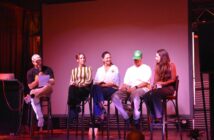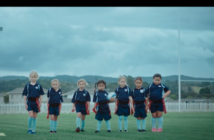.jpg)
September 28 last year marked one of the biggest events in recent Out-of-Home history, with oOh! and Adshel coming together to become truly unmissable in every sense, representing the biggest Out of-Home media company in New Zealand.
With more than 2,500 sites covering most markets, including the biggest digital network in New Zealand, the new-look company is the largest Out-of-Home operator reaching over 90 percent of the population.
“It’s about delivering more audience reach, more often and in more places” says Nick Vile, general manager for New Zealand. “We like to say ‘we are where people live, work, shop, play and study’ because we have the ability to reach them in all those environments.”
Earlier this year, that ability was put to use to pay respect to the victims of the Christchurch Terror Attacks. In the following days, oOh! used its coverage to spread a message of unity by suspending advertising on its digital screens and instead displaying a Koru-patterned heart.
And last year, oOh! collaborated with other Out-of-Home media providers to support Maori Language Week, demonstrating the power of digital Out-of-Home. 40 te reo Maori themed messages were displayed across the country, providing daily lessons on everyday words. The te reo themed messages were changed dynamically according to time and location-based elements such as weather and traffic.
Those campaigns demonstrate oOh!’s responsibility as a public space medium and when talking to Vile about its position, he discusses its duty to the public as much as its duty to advertising clients and its commercial partners.
“We’re really focused on our role as a public space medium, we have a duty to consumers to operate responsibly in that space whether it’s on their daily journey, or within the retail environment.”

Not one-size-fits-all
While oOh!’s scale offers advertisers the chance to reach far and wide, looking at the solutions it has to offer, bigger (size) doesn’t always mean best.
Vile says the scale also enables it to target audiences by proximity, location and environment. Dialling up contextual relevance, and therefore more effectiveness, digital has the ability to change creative and messaging based on location, time, weather amongst a few in real-time.
“We are literally everywhere and unmissable, we have the scale to be precise so whether it’s from audience planning or proximity targeting or a mass broadcast range perspective. We’ve got a solution that can fit all of those requirements.”
A recent example of utilising its digital capability was delivered as a ‘NZ first’ for Trade Me – a campaign that won Gold for MBM (Trade Me’s media agency) for Best Use of Technology at the 2019 Beacon Awards.
oOh! built a bespoke portal allowing Trade Me to dynamically update messages to specific sites and locations based on real-time Trade Me data.
About the campaign, Beacon Award judges said: “This campaign recognized true innovation in the media space. The technology developed for Trade Me actually delivered on the promise of digital Out-of-Home…Trade Me were the first to deliver it.”
Having worked to develop an industry-leading technology that delivers on the promise of digital, it’s no surprise then that as well as being involved in an award-winning campaign, oOh! was also named Media Business of the Year at the 2019 Beacon Awards.
![]()

On-road and off-road
Not only does oOh!’s reach allow it to target audiences and deliver dynamic messages, it can also follow customers along their path to purchase.
What Vile means by this is it’s in malls as well as on streets. Advertisers can draw attention to a product with oOh!’s Street Furniture network, priming commuters with a particular message and then reiterating that message at the point of purchase.
He says this is particularly valuable for FMCG brands wanting to be where the transaction takes place. Being in the retail space has further opportunities for advertisers with the ability to be interactive and Vile says the retail environment is the most engaging of all outdoor environments.
Unlike on the roadside where there are restrictions in place so as to not distract drivers, retail allows for full-motion video or to have passers-by interact with the content with sounds and touch.
“In the roadside environment, you can’t climb up a ladder and touch a billboard, but in that retail environment, you get lots of people and lots of dwell time,” Vile says.
Here he gives the example of its interactive panels. Positioned in malls, they enable brands to personally connect with shoppers through touchscreens, webcams, speakers and microphones. It’s a one:one immersive brand experience through which advertisers can host games or run competitions.
Classic remains solid
Though the power of digital generates plenty of discussion when talking about Out-of-Home, that’s not to say classic sites are facing redundancy. In fact, less than 10 percent of its assets are being digitised so classic remains important.
“Classic is a really cost-effective way to build reach. It’s still a very important part, particularly for the street furniture business.”
An automated future
Sitting in oOh!’s Ponsonby base, there are plenty of new digital screens around the room with some in the development phase and others already deployed.
There’s clearly innovation going on under the roof, and when asked what that technology might look like in the future, Vile says “automated”.
He says it’s working to get to an automated solution to enable clients to use the digital attributes with greater efficiency.
“The business is geared to ensure that we are able to easily deliver compelling advertising audience solutions delivered by our platforms.”
On the topic of tech, Vile also brings up facial recognition, acknowledging there’s a lot of talk about it as well as other advancements of this kind. However, he points out while those technologies sound exciting, they aren’t very relevant in the Out-of-Home environment.
“How does facial recognition work in an environment when you’ve got 100,000 people walking down the street in one day, with only a small window to actually then display a relevant ad?” he asks.
Instead, he says its focus will be on understanding the audience in real-time and delivering content that’s relevant to them.
“It’s about understanding who’s the audience in that environment at different times of the day, and then tailoring creative to reach the audience that over indexes at that time of day, and in that environment.”








